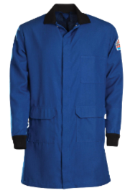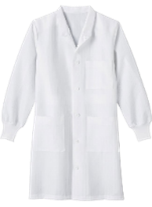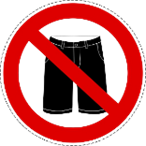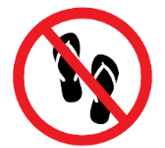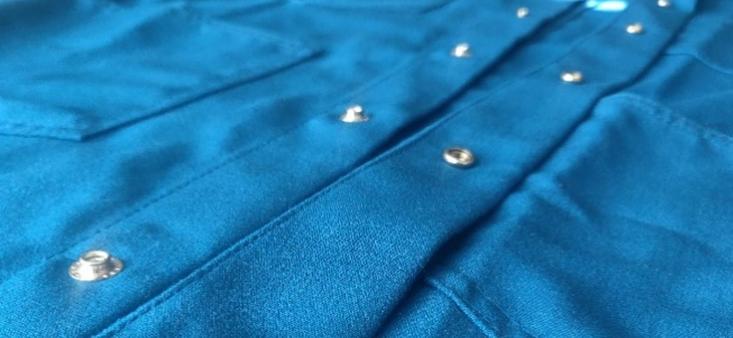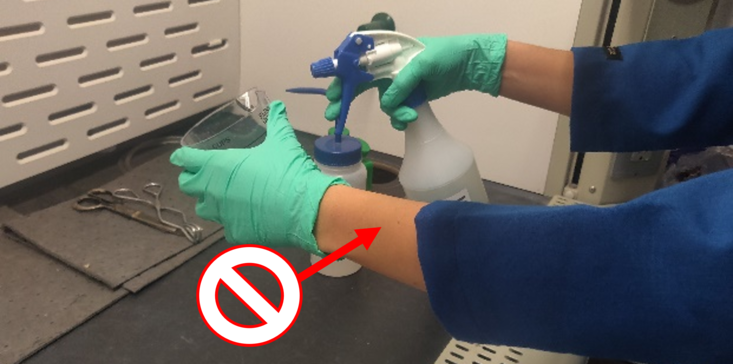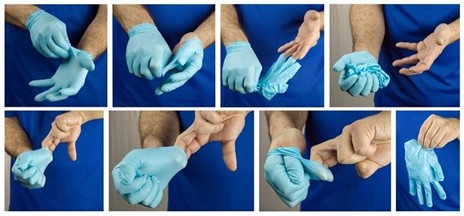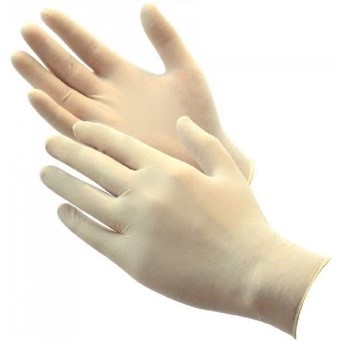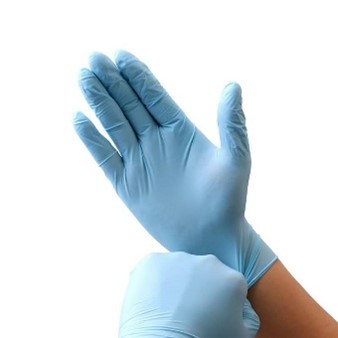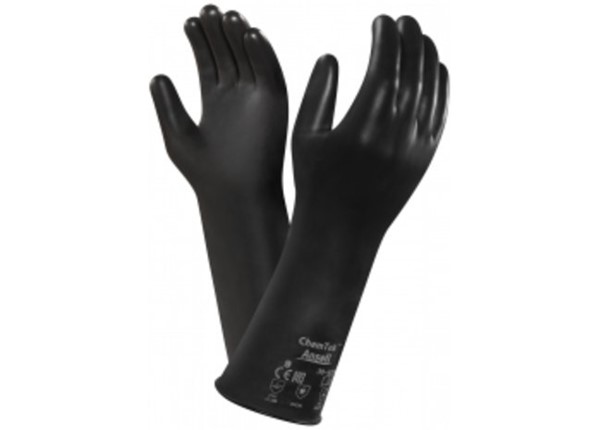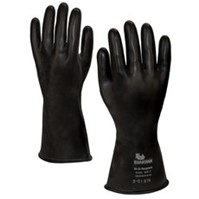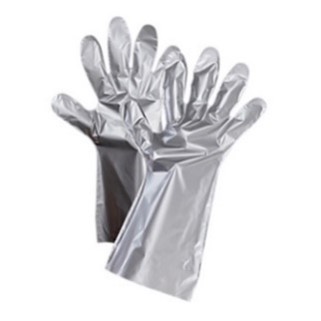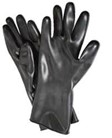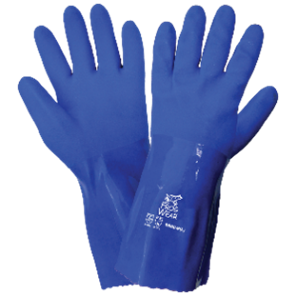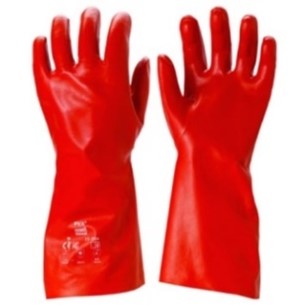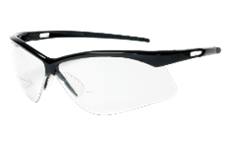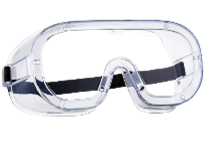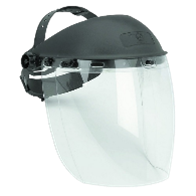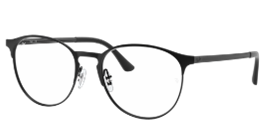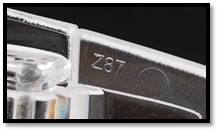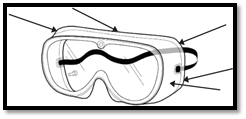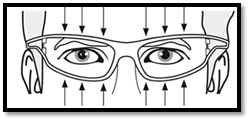Personal Protective Equipment (PPE)
UC Riverside uses the Laboratory Hazard Assessment Tool (LHAT) to identify and communicate hazards present in the laboratory or research area. Once hazards are identified, laboratory members must review and acknowledge the laboratory hazard assessment, complete a Personal Protective Equipment (PPE) training module via LHAT.
For questions or comments, please email us at ehslaboratory@ucr.edu or call (951) 827-5528.
Obtaining PPE
1. Request your Principal Investigator (PI) to add you to their laboratory's hazard assessment roster. (Note: If you are a PI, contact EH&S to begin a LHAT).
2. Review your PI's Laboratory Hazard Assessment by selecting it from the "Action Items" list or under the "Workspace" list.
3. Acknowledge your PI's listed laboratory hazards.
4. Complete the Risk and Safety Solutions PPE training module via the laboratory hazard assessment (not the UC Learning Center). Tip: Use Chrome browser.
5. Only when Steps 1-4 are complete, schedule a PPE fitting appointment. PPE fitting appointment is located at the EH&S office (295 West Linden Street). Bring your prescription glasses if you plan to wear them while working in the lab.
The University of California is committed to providing a healthy and safe working environment for all members of the campus community. This Personal Protective Equipment (PPE) policy is designed to prevent workplace injuries and illnesses for all academic appointees, staff, students, and visitors.
Minimum Attire and PPE when working with, or adjacent to, hazardous material use areas within a Laboratories/Technical Areas:
- Full length pants (or equivalent) and closed toe/heel shoe attire
- Laboratory coats (or equivalent protective garments)
- Protective eyewear
- Protective gloves
View the Full University of California, Personal Protective Equipment Policy
Laundering
View the NEW Lab Coat Laundering Program Flyer!
The Lab Coat Laundering Program, funded by Environmental Health & Safety, allows the campus to safely and appropriately launder soiled and contaminated lab coats that should not be laundered in domestic or commercial laundering facilities.
The Benefits of the Program include:
- Sustainability: Lab coats that are still appropriate for use in labs (not damaged beyond repair) can be appropriately laundered rather than disposed of and processed as hazardous waste, which would mean that replacements would not need to be purchased as frequently. Cleaned lab coats returned by staff and students leaving the university can also be returned to inventory for re-circulation, which also drives down the need to dispose of unused, but still good, coats as well as the need to constantly purchase more coats for onboarding staff and students.
- Environmentally Friendly: The Mission Linen laundering service would prevent hazardous materials removed from laundered lab coats from contaminating domestic and commercial laundering facilities not equipped to handle hazardous materials. Mission Linen facilities are also equipped to prevent the hazardous materials removed from laundered lab coats from entering sewer drains, which would otherwise harm the environment.
- Less Costly: Properly laundering lab coats costs the institution much less than purchasing new lab coats every time.
Who is Eligible?
All staff and students whose lab coats were issued by UCOP or UCR’s EH&S department are eligible to participate in this program. Coats issued by UCOP or UCR’s EH&S can be identified by the embroidery either on the sleeve or chest that says ‘University of California Be Smart About Safety’.
Don’t have UCOP or UCR EH&S issued PPE? Please visit this website to complete the requirements and book a PPE fitting appointment: https://ehs.ucr.edu/laboratory/ppe
Where to Drop-Off/Pick-Up Coats?
There are seven laundry locker locations on campus and each lab is assigned to a location based on their lab building. The campus is broken up into zones where all the buildings in one zone would be assigned to the locker location in that same zone.
Please view the Laundry Locker Map to identify your assigned laundry locker location building. Please view the floorplans to identify the exact location in each of the laundry location buildings. The lockers are marked by the star.
How to Launder Coats?
- Make sure your lab coats are barcoded with the appropriate Mission Linen barcode label at the nape of the collar and that the location number matches the locker location number you are using. The lockers have signs on them indicating their location number. Depositing lab coats without the correct location barcode may result in the lab coats being lost or delayed in laundering.
- If you need to have your lab coats barcoded or re-barcoded with a new location number, please make an appointment at: BARCODING APPOINTMENT.
- NOTE: Please bring in all the lab coats you need barcoded to the appointment, all appointments take place at the EH&S building.
- Make sure that you have another appropriate lab coat to use during the time your lab coats are being laundered.
- Make sure that your pockets are emptied. The lab coats are washed at 400°F so items such as pens, Sharpies, and plastic items can leave permanent stains and permanent residue on laundered lab coats.
- Mission Linen picks up soiled coats and drops off cleaned coats on Monday mornings EXCEPT during holidays and campus closures.
- Cleaned coats are typically returned within 2-3 weeks of having been picked up
Using the Clean Coat Lockers
Combination locks have been installed on the clean coat lockers for added security.
The combination codes have been provided to your Principal Investigators and Lab Safety Contacts, but will be changed annually or as needed.
- Turn the dials to the set 4-digit combination code.
- Push in on the door in the lock area to ensure it is aligned (the locks are not perfectly aligned otherwise) and slide the latch to the left by moving the knob to the left.
- Retrieve your cleaned lab coats, making sure they are yours by identifying the affixed name tag.
- Close the door, push in on the door in the lock area to ensure alignment, and slide the latch to the right by moving the knob to the right.
- Spin the dials again to move away from the set combination.
Troubleshooting
If your lab coats are lost, are not returned within 3 weeks, or are damaged, please contact ehslaboratory@ucr.edu .
Laboratory Coat Selection and Use
Guidance Document
A. PURPOSE
Lab coats ensure that your personal clothing and body are protected against contaminants and potential workplace accidents. Always wear your lab coat in the workplace to avoid tracking contaminants home and prevent bodily harm. Never underestimate the potential for laboratory hazards, regardless of how safe the workplace activities may seem.
All University of California, Riverside (UCR) students, faculty, staff, and affiliates (collectively, “UCR personnel”) are required to wear lab coats when:
- (i) Working with hazardous materials, including but not limited to, infectious materials, radioactive materials, chemicals, physical hazards (e.g., potential for flying objects/debris), and harmful temperature extremes; and,
- (ii) Working within a Laboratory/Technical Area, defined by the University of California – Office of the President (UCOP) PPE Policy as “a location where the use or storage of hazardous materials occurs or where equipment may present a physical or chemical hazard”. The use of lab coats should be appropriately selected on the basis of the present hazard(s).
The Laboratory Coat Selection and Use Guidance Document (the “Guidance Document”) is intended to provide instructions and information on determining when lab coats are required, lab coat considerations and limitations, selecting appropriate lab coat based on present hazards, and care, use, and disposal.
B. DETERMINING WHEN LAB COATS ARE REQUIRED
The Principal Investigator (PI)/Supervisor is required to assess hazards in the laboratory or research setting using the UCR Laboratory Hazard Assessment Tool (LHAT). The LHAT’s objectives are to determine if PPE is necessary and provide UCR personnel with guidance to select the appropriate PPE, including lab coats. The LHAT is UCR’s primary and recommended workplace hazard assessment process.
In addition to the LHAT, UCR personnel must also be aware of the present workplace hazards. As detailed in Section A of the Guidance Document, lab coats must be worn when working with hazardous materials or occupying a Laboratory/Technical Area; examples of these criteria requiring lab coats include:
Examples of Laboratory/Technical Areas |
Examples of Workplace Hazards/Associated Activities |
| Research Settings/Laboratories | Chemicals (solids/liquids/vapors/mists/sprays) |
| Teaching Settings/Laboratories | Biological Agents (blood/bacteria/viruses/fungi) |
| QA/QC and Analytical Laboratories | Dusts/Particles/Chips/Sand/Dirt |
| Stock/Storage Rooms | Torching/Welding/Soldering/Molten Metals/Sparks |
| Waste Accumulation Areas/Locations | Abrasive Blasting/Machining |
| Cold Rooms | Light Radiation (bright lights, ultraviolet, laser, welding) |
| Machine Shops/Workshops | Chopping/Chipping/Cutting/Drilling/Grinding |
| Vivaria | Hammering/Milling/Sanding/Sawing |
| Visual/Performing Arts Studios and Shops | Temperature Extremes (liquid nitrogen, sparks) |
If lab coats are required, follow the instructions outlined on the UCR Environmental Health & Safety (EH&S) Personal Protective Equipment (PPE) webpage to obtain either flame resistant or traditional lab coats at no charge. UCR EH&S will ensure that the issued lab coats are properly fitted to the individual and replace any damaged lab coats. Specialized lab coats (e.g., barrier lab coats, chemical-resistant aprons) must be provided by the workplace’s PI/Supervisor.
C. LAB COAT CONSIDERATIONS AND LIMITATIONS
No single lab coat is protective against all hazards – different types of lab coats provide different types of protection:
| Traditional lab coats are intended to protect against incidental splashes of hazardous materials. | |
|
Flame resistant lab coats are intended to protect the user when there is a risk of catching personal garments or skin on fire; flame resistant – not fire-proof. Must be worn when (i) working with any amount of pyrophoric materials, (ii) working with flammable liquids near potential ignition sources, or (iii) determined by the LHAT. |
|
|
Barrier lab coats (pinstriped) are intended to protect the user when there is a risk of splash from blood-borne pathogens or other biohazardous materials. |
|
|
|
Shorts or open-toed shoes must never be worn in a Laboratory/Technical Area or when working with or near hazardous materials, even under a lab coat. Full-length pants (or equivalent) and closed-toe/heel shoes must be worn for safety and compliance with the UCOP PPE Policy. |
| When wearing lab coats, ensure that the coats are fully buttoned/snapped to their full length. | Lab coat sleeves must be of a sufficient length to prevent direct skin exposure while wearing gloves. |
D. SELECTING APPROPRIATE LAB COAT BASED ON PRESENT HAZARDS
The below table, extracted from the University of California – Office of the President (UCOP) PPE Policy summarizes the appropriate PPE (including lab coats) to be worn based on the UCR workplace activity. Reference your LHAT for specific information on your workplace’s present hazard(s) and recommended PPE.
Chemical Hazards |
|||||
| Activity in a Lab |
Potential Hazard | Recommended Lab Coat Type | Additional PPE | ||
| Flame Resistant (NFPAA 2112) |
Traditional | Barrier | |||
| C01. Working with small volumes of corrosive (e.g. acids, caustics, etc.) liquids or solids. | Eye or skin damage. Low probability for a splash hazard. | X |
|
||
| C02. Working with corrosive or acutely toxic liquids or other materials which creates a splash hazard. | Poisoning, increased potential for eye and skin damage. | X |
|
||
| C03. Working with small volumes of flammable solvents/materials when no reasonable ignition sources are present. | Skin or eye damage, potential poisoning through skin contact. | X |
|
||
| C04. Working with flammable materials (including solvents): When using a large quantity; or, any quantity when there is a risk of ignition; or, areas where flammable vapors or gas are may be present. | Major Fire. Major skin or eye damage, potential poisoning through skin contact. | X |
|
||
| C05. Working with toxic or hazardous chemicals (solid, liquid, or gas). (including but not limited to GHS H301, H302, H311, H312, H331 H332) |
Skin or eye damage, potential poisoning through skin contact. | X |
|
||
| C06. Working with Acutely Toxic Chemicals. (GHS H300, H310, H330) |
Spills, splashes, ingestion, inhalation, absorption. Chemicals pose a high level of immediate health risk. | X |
|
||
| C07. Working with an apparatus with contents under pressure or vacuum. | Eye or skin damage. | X |
|
||
| C08. Working with pyrophoric (air reactive) chemicals or chemicals that in contact with water releases flammable gasses (water reactive). (GHS H25x and H26x) |
Severe skin and eye damage. Fire. |
X |
|
||
| C09. Working with potentially explosive chemicals. (e.g. Nitrates, Perchlorates, Azides, Nitrites etc.) | Splash, detonation, flying debris, skin and eye damage, fire. | X |
|
||
| C10. Minor chemical spill cleanup | Skin or eye damage, respiratory damage. | X |
|
||
| C11. Major chemical spill cleanup | Multiple hazards. | Call EH&S for assistance | |||
| C12. Working with known or suspect human carcinogens (GHS H350, H351) | Spills, splashes, ingestion, inhalation, absorption. High hazard cancer-causing agents. | X |
|
||
| C13. Working with reproductive hazards (GHS H340, H341, H360, H361) | Spills, splashes, ingestion, inhalation, absorption. Agents that affect reproductive capabilities, cause mutation and adversely affect fetal development. | X |
|
||
| C14. Working with engineered nanomaterials. | Inhalation, exposure, dermal exposure. | X |
|
||
Physical Hazards |
|||||
| Activity in Lab | Potential Hazard | Recommended Lab Coat Type | Additional PPE | ||
| Flame Resistant (NFPA 2112) |
Traditional | Barrier | |||
| P01. Working with cryogenic liquids. | Major skin, tissue, or eye damage. | X |
|
||
| P02. Removing freezer vials from liquid nitrogen. | Vials may explode upon rapid warming. Cuts to face/neck and frostbite to hands. | X |
|
||
| P03. Working with very cold equipment or dry ice. | Frostbite, hypothermia. | X |
|
||
| P04. Working with scalding liquids or hot equipment (e.g. autoclave, water bath, oil bath). | Burns resulting in skin or eye damage. | X |
|
||
| P05. Glassware washing. | Lacerations, chemical splash. | X |
|
||
| P06. Working with loud equipment, noises, sounds, alarms, etc. | Potential ear damage and hearing loss. | Earplugs or ear muffs as necessary | |||
| P07. Working with a centrifuge. | Imbalanced rotor can lead to broken vials, cuts, exposure. |
|
|||
| P08. Working with a sonicator. | Ear damage, exposure. | X |
|
||
| P09. Working with sharps (e.g. needles and razor blades.) |
Cuts, exposure. | X |
|
||
Biological Hazards*I have a BUA that addresses all of these items. Skip to next section. |
|||||
| Activity in lab | Potential Hazard | Recommended Lab Coat Type | Additional PPE | ||
| Flame Resistant (NFPA 2112) |
Traditional | Barrier | |||
| B01. Working with human or nonhuman primate blood, body fluids, tissues, cells or other potentially infectious material (OPIM) which may contain human blood borne pathogens (BBP). | Exposure to infectious materials and sharps injuries. |
X (Disposable) |
|
||
| B02. Working with microbial agents (bacteria, virus, parasites, yeast, fungi, prions), recombinant DNA and/ or biological materials (cells, tissues, fluids) exposed to or likely to contain Risk Group 1 microbial agents or recombinant DNA. (BSL-1) | Eye irritation, sharps injury. Exposure of infectious material to those who may have personal health issues which make them more susceptible to infection; cross contamination of animal or extra laboratory areas. |
X |
|
||
| B03. Working with microbial agents, recombinant DNA and/or biological materials (cells, tissues, fluids) exposed to or likely to contain Risk Group 2 microbial agents or recombinant DNA. (BSL-2) | Exposure to infectious material, particularly through broken skin or mucous membranes, sharps injuries. | X |
|
||
| B04. Working microbial agents, recombinant DNA and/or biological materials (cells, tissues, fluids) exposed to or likely to contain Risk Group 2 microbial agents or recombinant DNA for which Biosafety Level 3 practices are required. (BSL-2+) | Exposure to infectious materials with high risk of exposure by contact with skin or mucous membranes and/ other potential or unknown routs of entry and or increased consequences of exposure. Sharps injuries. | X |
|
||
| B05. Working with microbial agents, recombinant DNA and/or biological materials (cells, tissues, fluids) exposed to or likely to contain Risk Group 3 microbial agents or recombinant DNA. (BSL-3) | Exposure to infectious materials with high risk of exposure, particularly through the inhalation route. | Full back closing disposable gown or coveralls (preferred) |
|
||
| B06. Working with live animals- alone or in conjunction with Risk Group 1 microbial agents or recombinant DNA. (ASBL-1) | Animal bites, allergies, eye irritation, sharps injury. Exposure of infectious material to those who may have personal health issues which make them more susceptible to infection; cross contamination of animal or extra laboratory areas. |
X |
Additional PPE (e.g. puncture resistant gloves) may be required based on risk assessment by the IBC & IACUC. Additional gowning (shoe covers, face mask) may be required for animal welfare purposes. |
||
| B07. Working infected or potentially infectious live animals—alone or in conjunction with Risk Group 2 microbial agents or recombinant DNA (or materials exposed to RG-2 agents). (ABSL-2) | Animal bites, exposure to infectious material, allergies, sharps injury. | X |
Additional PPE (e.g. puncture resistant gloves) may be required based on risk assessment by the IBC & IACUC. Additional gowning (shoe covers, face mask) may be required for animal welfare purposes. |
||
Non-Ionizing Radiation Hazards |
|||||
| Activity in lab | Potential Hazard | Recommended Lab Coat Type | Additional PPE | ||
| Flame Resistant (NFPA 2112) |
Traditional | Barrier | |||
| N01. Working with ultraviolet radiation. | Conjunctivitis, corneal damage, skin redness. | X |
|
||
| N02. Working with infrared emitting equipment (e.g. glass blowing). | Cataracts, burns to cornea. | X |
|
||
Radiological Hazards* I have a RUA and/or MUA that addresses all these. Skip to next section. |
|||||
| Activity in lab | Potential Hazard | Recommended Lab Coat Type | Additional PPE | ||
| Flame Resistant (NFPA 2112) |
Traditional | Barrier | |||
| R01. Working with unsealed radioactive materials including generally licensed radioactive material or devices (e.g., uranyl acetate, uranyl nitrate, thorium, nitrate). | Cell damage, potential spread of radioactive materials. | X |
|
||
| R02. Working with unsealed radioactive materials in hazardous chemicals (corrosives, flammables, liquids, powders, etc.). | Cell damage or spread of contamination plus hazards for the specific chemical. | X |
|
||
| R03. Working with radioactive sealed sources or devices containing sources of radioactive materials (e.g., liquid scintillation counters, gas chromatographs/electron capture detectors, static eliminators, etc.) | If sealed source is compromised due to removal from equipment or physical abuse: cell damage, potential spread of radioactive materials. | PPE is not necessary under normal operating instructions. Note: Source may not be removed form device except by EH&S or manufacturer. |
|||
Laser Hazards |
|||||
| Activity in lab | Potential Hazard | Recommended Lab Coat Type | Additional PPE | ||
| Flame Resistant (NFPA 2112) |
Traditional | Barrier | |||
| L01. Open Beam- Performing alignment, trouble-shooting or maintenance that requires working with an open beam and/or defeating the interlock (s) on any Class 3 or Class 4 laser system. | Eye damage | Consider appropriate skin-covering clothing (e.g., tightly-woven fabrics). For Class 4 lasers, flame-retardant clothing is recommended |
|
||
| L02. Open Beam- Viewing a Class 3R laser beam with magnifying optics. | Eye damage | N/A | N/A | N/A |
|
| L03. Open Beam- Working with a Class 3B laser open beam system with the potential for producing direct or specular reflections. |
Eye damage | N/A | N/A | N/A |
|
| L04. Open Beam- Working with a Class 4 laser open beam system with the potential for producing direct, specular or diffuse reflections. | Eye damage, skin damage | Appropriate skin protection |
|
||
| L05. Non-Beam - Handling dye laser materials, such as powdered dyes, chemicals, and solvents. | Cancer, explosion, fire. | X |
|
||
| L06. Non-Beam- Maintaining and repairing power sources for large Class 3B and Class 4 laser. | Electrocution, explosion fire | X |
|
||
| L07. Enclosed Beam- Using a Class 1 device housing a Class 3B or Class 4 enclosed or embedded laser with the potential for beam exposure during a Service Event. |
Eye damage, skin damage | Appropriate skin protection |
|
||
E. CARE, USE, AND DISPOSAL
Lab coats should never be taken outside of the laboratory or research setting, as contaminants can be tracked to public settings or private residences. Additionally, lab coats should only be laundered at specialized facilities, i.e., lab coats should not be washed in standard residential or commercial laundry machines. Visit the UCR Lab Coat Laundering webpage for lab coat laundering instructions.
UCR personnel are responsible for periodically inspecting their PPE (including lab coats) for any damage that may compromise the PPE’s protective integrity. The PI/Supervisor should be informed of damaged PPE. UCR EH&S will replace damaged or heavily soiled lab coats at no charge. To replace damaged or heavily soiled lab coats, follow the instructions outlined on the UCR EH&S PPE webpage.
The PI/Supervisor is responsible for the proper disposal of damaged and heavily-soiled lab coats. Any protective clothing that becomes contaminated with hazardous materials must be decontaminated or appropriately discarded based on the contamination category (e.g., biological, chemical). For good-condition lab coats that are no longer used, contact ehslaboratory@ucr.edu for EH&S drop-off instructions.
Protective Glove Selection and Use
Guidance Document
A. PURPOSE
All University of California, Riverside (UCR) students, faculty, staff, and affiliates (collectively, “UCR personnel”) are required to use protective gloves, when handling infectious materials, radioactive materials, chemicals, and harmful temperature extremes; or when performing other inherently hazardous activities. The protective gloves should be appropriately selected on the basis of the present hazard(s).
The Protective Glove Selection and Use Guidance Document (the “Guidance Document”) is intended to provide instructions and information on performing a hazard assessment to determine if protective gloves are necessary, appropriate selection of protective gloves, donning/doffing and disposal of protective gloves, allergy information, and limitations of protective gloves.
B. HAZARD ASSESSMENT
The Principal Investigator (PI)/Supervisor is required to assess hazards in the laboratory or research setting using the UCR Laboratory Hazard Assessment Tool (LHAT). The LHAT’s objectives are to determine if protective gloves are necessary, provide UCR personnel with guidance to select the appropriate gloves, and training in the use of protective gloves among other personal protective equipment (PPE). In addition to considering the protective gloves recommended by the LHAT, UCR personnel must carefully review and understand (i) the considerations/limitations associated with protective gloves and (ii) proper procedures for donning/doffing protective gloves, as outlined in Sections D and E of this Guidance Document.
The LHAT is UCR’s primary and recommended workplace hazard assessment process. However, in the event that the LHAT cannot be completed or is inapplicable, such as when potential hazards are present outside of a typical workplace setting (i.e., laboratory, research environment), the PI/Supervisor is responsible for the hazard assessment process. The PI/Supervisor should then complete a Job Hazard Analysis form for submittal to the UCR Industrial Hygiene (IH) Department via ehsih@ucr.edu.
C. RECEIVING PROTECTIVE GLOVES
Based on the inputted workplace hazards, the LHAT will recommend protective glove(s) to be used, if necessary. The PI/Supervisor should provide UCR personnel with the protective gloves recommended in the LHAT.
If the LHAT recommends the use of fire-resistant protective gloves (e.g., due to the handling of pyrophoric materials), the UCR Environmental Health & Safety department (EH&S) will issue fire-resistant gloves. In the LHAT, UCR personnel must first “acknowledge” the workplace hazards outlined by the LHAT and complete an online training module. After which, an appointment can be scheduled via the UCR PPE Request webpage to receive the fire-resistant gloves; please print and bring a copy of the PPE voucher (issued via the LHAT website) to the scheduled PPE appointment.
D. GLOVE CONSIDERATIONS AND LIMITATIONS
Different types of gloves provide different types of protection. No single protective glove is protective against all potentially present hazards (e.g., chemical, fire), and no protective glove is completely impermeable. Depending on the hazardous substances present in the workplace, a combination of protective gloves may provide the necessary protection.
To ascertain which protective glove material is most suitable for a particular hazardous exposure, always refer to the Safety Data Sheet (SDS) of the chemicals present in the workplace environment, the protective glove manufacturer, and consult the National Institute for Occupational Safety and Health (NIOSH) Recommendations for Chemical Protective Clothing Database. A general non-exhaustive glove selection guidance table is presented in Section G of this Guidance Document. When selecting the appropriate protective glove, consider the following factors:
- Chemical type
- Temperature extremes
- Equipment used (e.g., sharps, piercing objects)
- pH
- Toxicity
- Duration of contact
Additionally, the following protective glove characteristics, techniques, and equipment should be considered:
- Double gloving – A second set of protective gloves may be worn over the initial set of protective gloves to provide an additional layer of protection. If the outer set of protective gloves becomes damaged or contaminated, the inner set of gloves will continue to provide protection until the outer set of protective gloves is replaced. The physical characteristics (e.g., swelling, cracking) of the outer set of gloves should be closely monitored; if signs of damage or contamination are observed, promptly dispose of and replace the outer set protective glove. The combination of double gloves used should not significantly hinder the UCR personnel’s dexterity, which may ultimately result in the unsafe handling of hazardous materials.
- Sleeve length – At a minimum, the worn protective gloves should cover the wrists. Ensure that the protective gloves overlap the cuffs of the laboratory coat or overalls, and that the sleeve lengths of the worn protective gloves are appropriate for the present workplace hazards.
- Glove boxes – A glove box is a sealed container, equipped with protective gloves, used to manipulate hazardous materials with minimal exposure. Glove boxes generally provide adequate protection from highly-hazardous substances. The following general considerations should be understood prior to the operation of a glove box; always consult the glove box’s operating manual prior to the use of a glove box.
- The glove box should first be inspected for damage or leaks; a glove box should never be operated if the glove box’s protective gloves are suspected of damage (e.g., pinholes, tears) or if there is indication of a leak in the glove box. Promptly notify your PI/Supervisor if a glove box is suspected of damage or a leak.
- Nitrile gloves should be donned prior to operation of the glove box, which will act as a base protection layer. The base pair of nitrile gloves will also keep the glove box’s protective gloves clean from sweat, which may degrade the protective glove material (e.g., rubber).
- Use of sharps in the glove box should be minimized. If the use of sharps in the glove box is necessary, extreme caution should be exercised. Additionally, the glove box’s protective gloves should be operated slowly and carefully; abrupt movements or “pumping” of the glove box’s protective gloves may result in a pressure differential which may present safety concerns.
The condition and effectiveness of the protective gloves in use should be closely monitored. Generally, protective glove effectiveness is measured in the below-listed characteristics. If any observable changes are noted in the protective gloves’ physical characteristics (e.g., swelling, cracking), promptly dispose of and replace the protective gloves. Disposable gloves should never be reused.
- Degradation — A change in a glove’s physical characteristics (e.g., swelling, softening, cracking, tears, change in color or texture).
- Permeation rate — The speed at which a hazardous substance penetrates the glove material.
- Breakthrough time — The time between initial contact and first detection of the hazardous substance inside the glove.
E. PROTECTIVE GLOVE DONNING, DOFFING, AND DISPOSAL
The terms donning and doffing refer to the practice of dressing (donning) and undressing (doffing) PPE. It is critical that PPE, including protective gloves, is properly donned/doffed to avoid direct contact with contaminants (i.e., transmission, exposure) and subsequent contamination of non-workplace surfaces (e.g., dining areas). The following instructions outline safe practices in donning/doffing protective gloves.
Donning Protective Gloves –
- Prior to use, inspect the appropriately-selected protective gloves for holes, punctures, tears, cracking, and discoloration. If any observable changes are noted in the protective glove’s physical characteristics (e.g., swelling, cracking), promptly dispose of and replace the protective glove. Protective gloves that have been used for an extended period of time may be at higher risk of degradation.
- Prior to donning the protective gloves, ensure that the protective gloves are of proper size for the UCR personnel. Improperly sized gloves (e.g., too small or large) may result in tears or dexterity issues which could compromise safety.
- Hands should be thoroughly washed prior to donning protective gloves. In an uncontaminated work area, insert five fingers into the cuff of the first protective glove, and pull the cuff over the wrist; repeat this process with the second protective glove. For disposable gloves (e.g., nitrile, latex), ensure a secure fit around the palms and wrists; the cuffs should fit snuggly around the wrists.
Doffing Disposable Protective Gloves –
- Prior to doffing protective gloves, it should be understood that disposable gloves should never be washed or reused.
- Disposable protective gloves should be doffed prior to exiting the workplace; it is critical that contaminated protective gloves are not worn or doffed outside the immediate workplace. UCR personnel must be prudent in avoiding protective glove contact with public/non-workplace-related surfaces such as office/mobile phones, door handles, and public drinking fountains.
- Following hazardous workplace activities, the dominant hand should be used to pinch the outer surface of the non-dominant hand’s cuff, and carefully pull off the non-dominant hand’s protective gloves. The removed protective glove should then be balled by the worn protective glove. After which, two fingers should be slipped beneath the gloved hand and carefully peeled off the hand until it is inside out. The below images depict the aforementioned disposable protective glove doffing process. Throughout the doffing process, the UCR personnel must be mindful not to touch the bare skin of the hand or wrist with the outer surface of the contaminated protective gloves. The doffed protective gloves can then be disposed.
Doffing Reusable Protective Gloves –
- Protective gloves should be doffed prior to exiting the workplace; it is critical that contaminated protective gloves are not worn or doffed outside the immediate workplace. UCR personnel must be prudent in avoiding protective glove contact with public/non-workplace-related surfaces such as office/mobile phones, door handles, and public drinking fountains.
- If authorized based on the handled chemicals, rinse and wash the exterior surface of the reusable protective gloves. Carefully loosen both protective gloves by slightly pulling on the glove fingertips. The protective gloves should be handled by the cuffs and placed in a designated storage area (e.g., drying rack), located away from chemical(s) and uncontaminated areas. The protective glove storage area should be assumed to be contaminated. Throughout the doffing process, the UCR personnel must be mindful not to touch the bare skin of the hand or wrist with the outer surface of the contaminated protective gloves.
Proper Disposal of Protective Gloves –
If the protective gloves are not contaminated with any hazardous substances, they may be disposed of in the general trash. However, if the waste protective gloves are suspected to be contaminated by radioactive, chemical, or biohazardous substances, they should be handled and disposed of in accordance with appropriate hazardous waste management requirements, as outlined by UCR’s Hazardous Waste Management webpage and the UCR Laboratory Waste Disposal Requirements Guide.
F. ALLERGY INFORMATION
Use of natural rubber or latex protective gloves may result in allergic reactions such as irritant contact dermatitis, allergic contact dermatitis, and general latex allergic reactions.
|
Mild symptoms may include: • itchiness |
More-severe symptoms may include: • sneezing |
The most-severe reaction to natural rubber or latex protective gloves is anaphylaxis, an acute allergic reaction which is potentially life-threatening. UCR personnel should be aware of these potential allergic reactions prior to the use of natural rubber or latex protective gloves. If the above-listed symptoms are observed, the natural rubber or latex protective gloves should be promptly doffed and the PI/Supervisor notified.
G. PROTECTIVE GLOVE COMPARISON TABLE
The following protective glove comparison table is intended to provide general guidance for selecting protective gloves; the information provided in the protective glove comparison table is not exhaustive of all potential hazards associated with hazardous substances encountered in the workplace. The information contained within this table should be referenced in combination with the protective glove recommendations provided by the LHAT, and the protective glove considerations and limitations outlined in Section D of this Guidance Document. Manufacturer databases or websites, such as the Cole Palmer Safety Glove Chemical Compatibility Database, may also be referenced to determine which protective gloves are effective against a certain hazardous substance.
| Protective Glove Material | Intended Use | Advantages | Disadvantages | Sample Photograph |
|
Latex (natural rubber)* *Note: Hypoallergenic gloves, glove liners, and powderless gloves may provide the necessary protection for those with allergies to natural rubber and latex. |
Incidental contact |
|
|
|
| Nitrile |
Incidental contact Extended contact |
|
|
|
| Butyl rubber | Extended contact |
|
|
|
| Neoprene | Extended contact |
|
|
|
|
Norfoil (Silver Shield)* *Note: Dexterity can be partially regained by using a heavier weight Nitrile glove over the Norfoil/Silver Shield glove |
Extended contact |
|
|
|
| Viton | Extended contact |
|
|
|
| Polyvinyl chloride (PVC) | Specific use |
|
|
|
| Polyvinyl alcohol (PVA) | Specific use |
|
|
|
|
Stainless steel, Kevlar, leather* *Note: If there is potential for biological or chemical contamination, wear appropriate disposable gloves over the cut-resistant gloves and discard after use |
Specific use |
|
--- | |
|
Cryogenic resistant material, leather* *Note: Never dip gloves directly into liquid nitrogen |
Specific use |
|
--- |
Safety Eyewear Selection and Use
Guidance Document
A. PURPOSE
Safety eyewear is essential in preventing eye injuries, such as chemical splash or blunt impact, and should always be worn in the workplace where these hazards may be present. Never underestimate the potential for eye injury, regardless of how safe the workplace activities may seem. According to the U.S. Bureau of Labor Statistics, approximately 20,000 eye injuries occur in the workplace each year – a vast majority of these eye injuries can be prevented with use of the appropriate safety eyewear.
All University of California, Riverside (UCR) students, faculty, staff, and affiliates (collectively, “UCR personnel”) are required to wear safety eyewear when:
(i) Working with hazardous materials, including but not limited to, infectious materials, radioactive materials, chemicals, physical hazards (e.g., potential for flying objects/debris), harmful temperature extremes, light radiation (e.g., ultraviolet light, lasers); and,
(ii) Working within a Laboratory/Technical Area, defined by the University of California – Office of the President (UCOP) PPE Policy as “a location where the use or storage of hazardous materials occurs or where equipment may present a physical or chemical hazard”. The use of safety eyewear should be appropriately selected on the basis of the present hazard(s).
The Safety Eyewear Selection and Use Guidance Document (the “Guidance Document”) is intended to provide instructions and information on determining when safety eyewear is required, safety eyewear considerations and limitations, using only American National Standards Institute (ANSI)-certified safety eyewear, selecting appropriate safety eyewear based on present hazards, care and use, and first aid for eye injuries.
B. DETERMINING WHEN SAFETY EYEWEAR IS REQUIRED
The Principal Investigator (PI)/Supervisor is required to assess hazards in the laboratory or research setting using the UCR Laboratory Hazard Assessment Tool (LHAT). The LHAT’s objectives are to determine if safety eyewear is necessary and provide UCR personnel with guidance to select the appropriate safety eyewear. The LHAT is UCR’s primary and recommended workplace hazard assessment process.
In addition to the LHAT, UCR personnel must also be aware of the present workplace hazards. As detailed in Section A of the Guidance Document, safety eyewear must be worn when working with hazardous materials or occupying a Laboratory/Technical Area; examples of these criteria requiring safety eyewear include:
|
Examples of Laboratory/Technical Areas • Research Settings/Laboratories |
Examples of Workplace Hazards/Associated Activities • Chemicals (solids/liquids/vapors/mists/sprays) |
If safety eyewear is required, follow the instructions outlined on the UCR Environmental Health & Safety (EH&S) Personal Protective Equipment (PPE) webpage to obtain safety glasses and goggles at no charge. UCR EH&S will ensure that the issued safety eyewear is properly fitted to the individual and replace any damaged safety eyewear. Specialized safety eyewear (e.g., welding helmet, laser/UV safety glasses) must be provided by the workplace’s PI/Supervisor.
C. SAFETY EYEWEAR CONSIDERATIONS AND LIMITATIONS
Different types of eyewear provide different types of protection:
| Impact Resistant Safety Glasses are intended to protect the user's eyes when working with materials that may fly towards the user's face, impacting the eyes. | |
| Splash Goggles are intended to protect the user’s eyes against the risk of hazardous materials in a non-solid phase, such as liquids, sprays, and splashes. Additionally, safety goggles may be worn to reduce eye exposure to nuisance dusts. | |
| Face Shields may be worn as secondary eye and face protection over safety eyewear. Note that face shields may not be worn as a substitute for safety eyewear, i.e., safety goggles or glasses must be worn underneath a face shield. | |
| Prescription Eyeglasses are *not* suitable eye protection and should never be used as a substitute for safety eyewear. Reference Section D of the Guidance Document for additional information. EH&S offers standard safety glasses and goggles, including styles designed to fit over prescription eyeglasses. |
D. USING ONLY ANSI-CERTIFIED SAFETY EYEWEAR
Only use safety eyewear that has been ANSI-certified. Safety eyewear marked with “Z87” or “Z87+” have been tested and certified by ANSI to withstand impact. Notably, “Z87+” certified safety eyewear meets a higher impact standard and goes through more testing than “Z87” certified safety eyewear. For workplaces with high-risk of eye damage, contact EH&S for recommendations.
It is important to note that prescription eyeglasses do *not* provide suitable eye protection, unless the prescription eyeglasses have been specifically manufactured for eye protection and are ANSI-certified. Prior to donning safety eyewear, inspect the frame or lenses for a “Z87” or “Z87+” marking before use.
|
When wearing safety goggles, ensure a snug seal between the face and goggles. |
When wearing safety glasses, ensure minimal gaps between the glasses and eyes in all directions. |
E. SELECTING APPROPRIATE SAFETY EYEWEAR BASED ON PRESENT HAZARDS
| Present Hazard |
Minimum Safety Eyewear Required (properly fitted and ANSI certified) |
Additional PPE Considerations |
| Flying Objects or Debris | Safety glasses with side protection or goggles | Side protectors or face shield may be used to supplement the minimum safety eyewear required. |
| Heat (sparks, molten splash, high temperature) |
Safety goggles and a face shield | Consider protection against optical radiation (e.g., reflective or screened face shield). See below radiation-related activities. |
| Cryogenic materials or liquids | Safety goggles and a face shield | Consider additional cryogenic-resistant PPE (e.g., cryogenic gloves). |
| Chemical splashes, droplets, sprays; irritating mists | Safety goggles | Face shield may be used to supplement the minimum safety eyewear required. |
| Nuisance and Fine Dusts | Safety goggles | Consider frequent cleaning and closing goggle vents when possible. |
| Various Types of Welding | Welding helmet over safety glasses or goggles. The welding helmet must be equipped with the appropriate filter lens for the present optical radiation hazard(s), such as ultraviolet/infrared radiation or glare. | Additional welding safety controls and PPE should be implemented. Consider Hot Work Program eligibility. |
| Infrared Radiation | Infrared safety glasses with side protection or infrared goggles, rated to protect against the specific wavelength present | Face shield or welding helmet may be worn over the minimum safety eyewear, as required. |
| Bright Lights/Glare | Safety glasses with side protection or safety goggles, rated to protect against the brightness of present light | Face shield or welding helmet may be worn over the minimum safety eyewear, as required. |
| Lasers | Laser safety glasses with side protection, rated to protection against the specific wavelength present | Additional laser safety controls and PPE should be implemented. |
| Ultraviolet Light | Ultraviolet safety glasses with side protection or ultraviolet goggles, rated to protect against the specific wavelength present | Face shield or welding helmet may be worn over the minimum safety eyewear, as required. |
F. CARE AND USE
Prior to wearing any PPE, including safety eyewear, the user should first inspect the PPE for any signs of damage, such as scratches or cracks. If the safety eyewear is found to be damaged, UCR EH&S will then replace the safety eyewear (see Section B). Damaged safety eyewear may reduce the user’s ability to see and break upon impact. Safety eyewear should be cleaned with water and lens-safe tissues. Ensure proper storage to prevent unnecessary wear and tear.
G. FIRST AID FOR EYE INJURIES
| Eye Injury | First Aid Procedures |
| Chemical Exposure |
|
| Blunt Impact |
|
| Foreign Particle in Eye |
|
Instructional laboratory courses and short-term programs (six weeks or less) that include laboratory work may request Loaner PPE for the duration of the course or program.
PPE that will be available for loan include:
- Traditional white laboratory coats with snap fasteners
- Safety impact glasses (meets ANSI Z87+ standards)
How to request Loaner PPE:
No less than TWO BUSINESS WEEKS prior to needing the PPE, submit a request to EH&S using the "Loaner PPE Request Form" and EH&S will reach out to you within one business day.
For more information, refer to the Loaner Personal Protective Equipment (PPE) program document.
Slip Resistant Shoe Program
The goal of this program is to provide high quality highly slip- resistant footwear at no cost to host departments to all food service workers, and optionally to custodial staff and other workers with high slip-hazard work, at a frequency of every 6-months during their employment at any UCR.
UCOP Risk Management implemented the UC system-wide Slip-Resistant Footwear (SRF) Program initially for food service and custodial employees with the goal of reducing the frequency and cost of slip and fall injuries by 50% in these job classifications.
By implementing this program in these indoor high-hazard slip/trip/fall job classifications, pilot studies have already demonstrated a 5-fold reduction in slip/fall injuries with comparable payback to operations throughout the system. The program has been broadened to include other workers in high slip-hazard work environments on a department job-class-by-job-class basis with review and approval for inclusion in the SRF program by UCOP and Environmental Health & Safety
Please contact Environmental Health & Safety if you have any questions about the Slip Resistant Footwear Program.
Slip Resistant Footware Catalogs
| SR Max | Shoes for Crews |
| Women's Styles | Women's Styles |
| Men's Styles | Men's Styles |
| Work Boots | Work Boots |
| Waterproof Boots | Waterproof Boots |
| Insoles | Insoles |
Resources
Where is Environmental Health & Safety (EH&S)?
EH&S Building is located at the intersection of Pentland Way and Linden Street, next to the Transportation and Parking Services (TAPS) office. Location Map
Do I need to schedule an appointment to get PPE?
Yes. The process takes approximately 15 minutes and includes selection of PPE, fitting of PPE, and customizing of PPE. It is important that you book an appointment so the necessary time is allotted for your visit.
What do I bring to my appointment?
Bring your PPE voucher and a form of ID. We need to verify that we are outfitting the right person.
How do I obtain a voucher?
Once you have acknowledged the hazard assessment and completed the PPE training video, you will be able to download the voucher. Bring a hard-copy of your voucher to your scheduled PPE appointment.
Who completes the hazard assessment?
Your PI completes the laboratory hazard assessment, and you will review and acknowledge it.
Can I pick up PPE for myself and a fellow lab member?
No, only the individual who scheduled an appointment can collect their own PPE. The fitting component is requisite for PPE therefore proxies are not acceptable.
How can I get my lab coat laundered?
The campus storehouse offers laundering services for a nominal fee when an FAU number is provided. Visit the Request Lab Coat Laundering website or contact storehouse staff (x:2-5542) to learn more.
I'm having issues with Risk and Safety Solutions suite (such as LHAT). How do I clear my browser cache?
Clearing your browser cache will resolve most issues when using the UC Safety suite of applications. Follow the instructions below for your preferred browser.:
- Mozilla Firefox: Open the browser and click on the three horizontal lines near the top right of the window and click "Options". In the box that pops up, click on the "Advanced" tab. Within "Advanced" find the "Network" tab in the middle. There is a section that says "Cached Web Content". Click the "Clear now" box next to it.
- Google Chrome: Open the browser and click on the three horizontal lines near the top right of the window and click "Settings". Scroll down and near the bottom, click "Show advanced Settings". In the "Privacy" section, click the button that says "Clear browsing data". In the drop down menu, choose "the last four weeks" and only check the "Cookies and other site and plug-in d
- Internet Explorer: Open the browser and click the gear icon near the top right of the window and choose "Internet options". In the "General" tab, find the "Browsing history" section and click "Delete". Check the boxes for "Temporary Internet files and w

